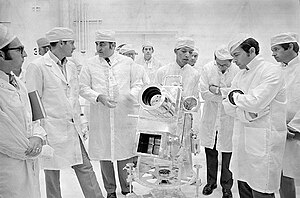BLACK SOCIAL HISTORY George Robert Carruthers
| BLACK SOCIAL HISTORY |
| George Robert Carruthers | |
|---|---|

George Carruthers, center, discusses the Lunar Surface Ultraviolet Camera with Apollo 16 CommanderJohn Young, right. From left are Lunar Module PilotCharles Duke and Rocco Petrone, Apollo Program Director.
| |
| Born | October 1, 1939 Cincinnati, Ohio |
| Nationality | United States |
| Fields | physics |
| Notable awards | Arthur S. Flemming Award (Washington Jaycees), 1970 |
George Robert Carruthers (born October 1, 1939) is an African-American inventor, physicist, and space scientist. He has lived most of his life in Washington, DC.[1]
Biography
From a young age he showed an interest in science and astronomy. He grew up in the South Side of Chicago where at the age of 10 he built his first telescope. Despite his natural aptitude, he did not perform well in school at a young age, earning poor grades in math and physics. Despite his poor grades he won three separate science fair awards during this time.
After graduating from Englewood High School he went on to get a bachelor's degree in aeronautical engineering from theUniversity of Illinois in 1961, a master’s degree in nuclear engineering in 1962, and a doctorate in aeronautical and astronautical engineering in 1964. He now works with NRL’s community outreach organization, and as such helps support several educational activities in the sciences in the Washington D.C. area.
His work on ultraviolet spectrums and other types of astronautical tools helped him earn the Black Engineer of the Year award, of which he was one of the first 100 people to receive. His work has also been used by NASA, and in 1972 he was one of two naval research laboratory persons whose work culminated in the camera/spectrograph which was put on the moon in April 1972.
He is perhaps best known for his work with the spectrograph that showed incontrovertible proof that molecular hydrogen exists in the interstellar medium.
George Robert Carruthers was born in Cincinnati, Ohio, on October 1, 1939,[2] and grew up in South Side, Chicago. His father was a civil engineer and his mother was a homemaker. The family lived in Milford, Ohio, until Carruthers' father died suddenly and his mother moved the family back to her native Chicago. At an early age George developed an interest in physics, which his father encouraged. Also as a child, he enjoyed visiting Chicago museums, libraries and the Adler Planetarium that caused him to be an avid science-fiction reader and enjoyed constructing model rockets. Later he became a member of the Chicago Rocket Society and various science clubs.[2]
In 1957, he earned his high school diploma[2] from Englewood High School. This was the same year that the Russians launched the first Sputnik. After high school he entered to the College of Engineering at the University of Illinois, getting his bachelor's of science degree in aeronautical engineering in the year of 1961. He also did his graduate work at the University of Illinois earning his master's degree in nuclear engineering in 1962 and his Ph.D. in aeronautical and astronomical engineering in 1964. While conducting his graduate studies, Carruthers worked as researcher and teaching assistant studying plasma and gases.[2]
By 1964, Carruthers began employment for the U.S. Naval Research Laboratory in Washington, D.C., where his work focused on far ultraviolet astronomy.[2] 1969 was the year he received a patent for his invention, the "Image Converter," which detected electromagnetic radiation in short wavelengths,[2] and in 1970, he made the first examination of molecular hydrogen in space. Two years later, Carruthers invented the first moon-based observatory, the Far Ultraviolet Camera/Spectrograph, which was used in the Apollo 16 mission.[2] During the 1980s, Carruthers helped create a program called the Science & Engineers Apprentice Program, which allows high school students to spend a summer working with scientists at the Naval Research Laboratory. Later on in 1986, one of Carruthers' inventions captured an ultraviolet image of Halley's Comet. In 1991, he invented a camera that was used in the Space Shuttle Mission. During the summers of 1996 and 1997 he taught a course in Earth and Space Science for D.C. Public Schools Science teachers. He also helped develop a series of videotapes on Earth and Space science for high-school students.
Since 1983 he has been Chairman of the Editing and Review Committee and Editor, Journal of the National Technical Association.
Since 2002, Carruthers has been teaching a two-semester course in Earth and Space Science at Howard University sponsored by a NASA Aerospace Workforce Development Grant.
On February 12, 2009, Carruthers was honored as a Distinguished Lecturer at the Office of Naval Research for his achievements in the field of space science.
On February 1, 2013, Dr. Carruthers was awarded the 2012 National Medal of Technology and Innovation by President Barack Obama at the White House.[3]
He is a member of the American Astronomical Society, the American Geophysical Union, the American Institute of Aeronautics and Astronautics, the American Association for the Advancement of Science and the National Society of Black Physicists.
Awards
- Arthur S. Flemming Award (Washington Jaycees), 1970
- Exceptional Achievement Scientific Award Medal NASA 1972
- Warner Prize of the American Astronomical Society
- National Science Foundation Fellow
- Honorary Doctor of Engineering, Michigan Technological University
- National Medal of Technology and Innovation, 2012































































































































No comments:
Post a Comment